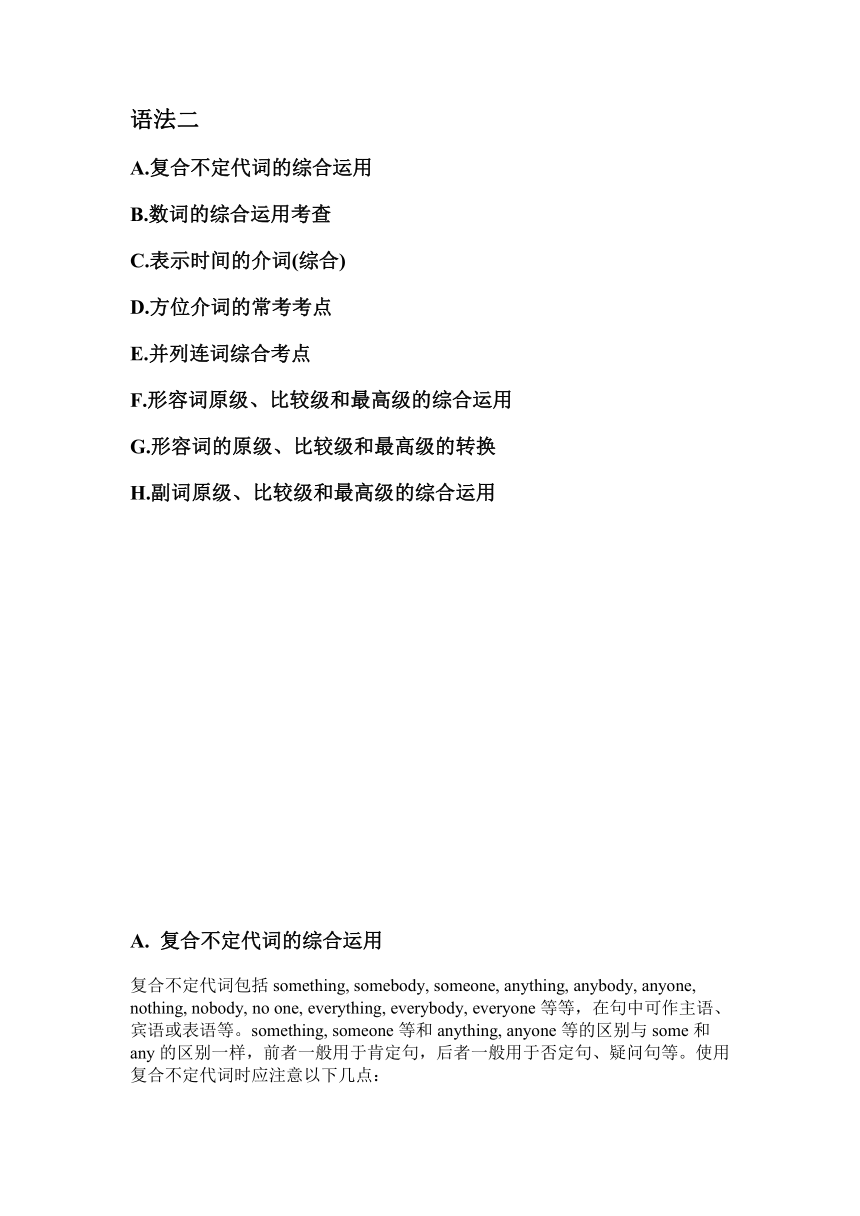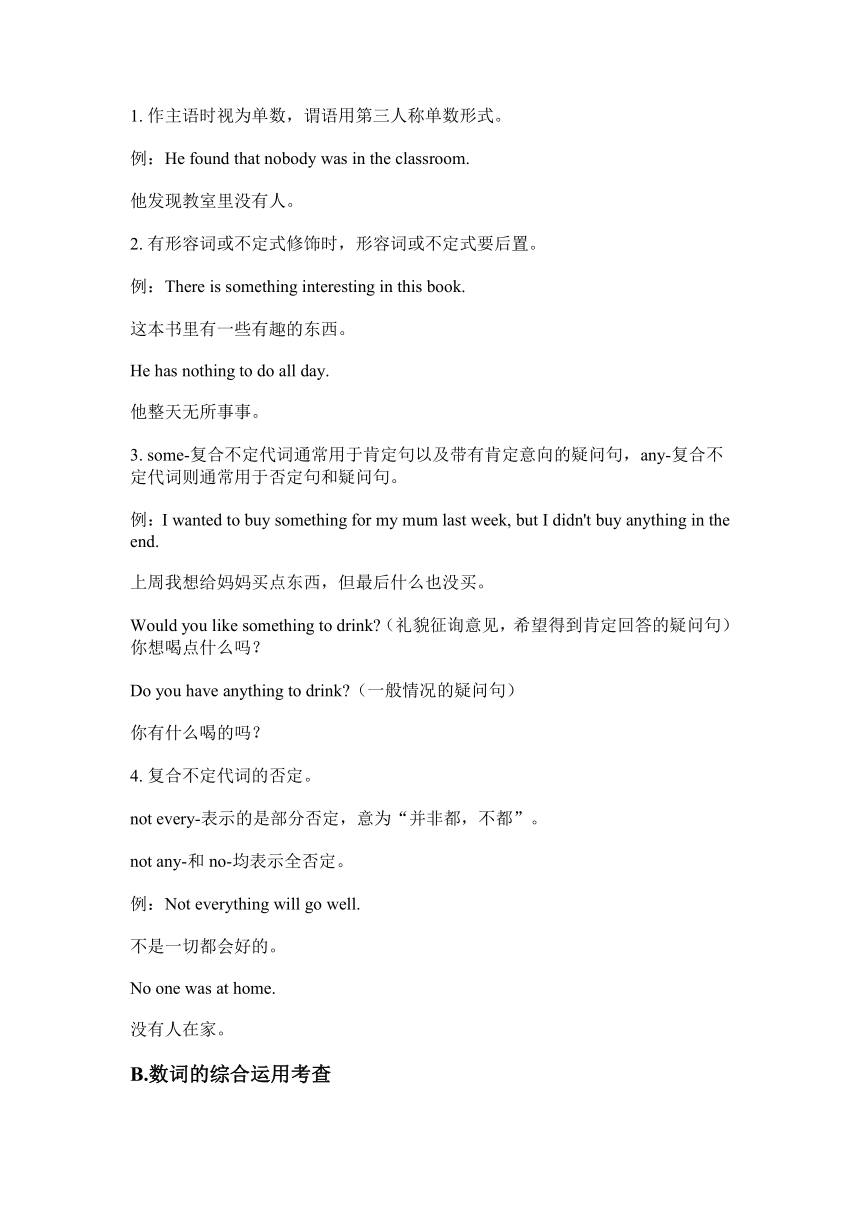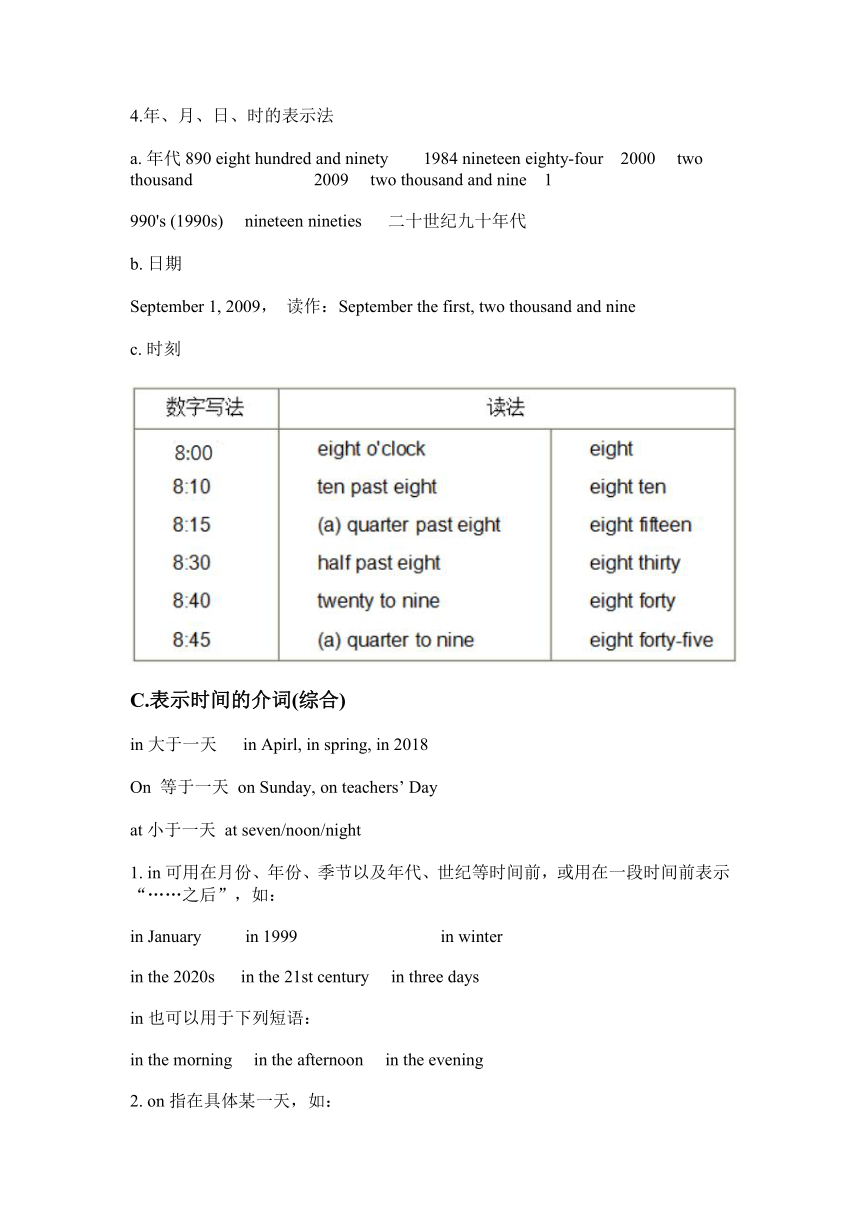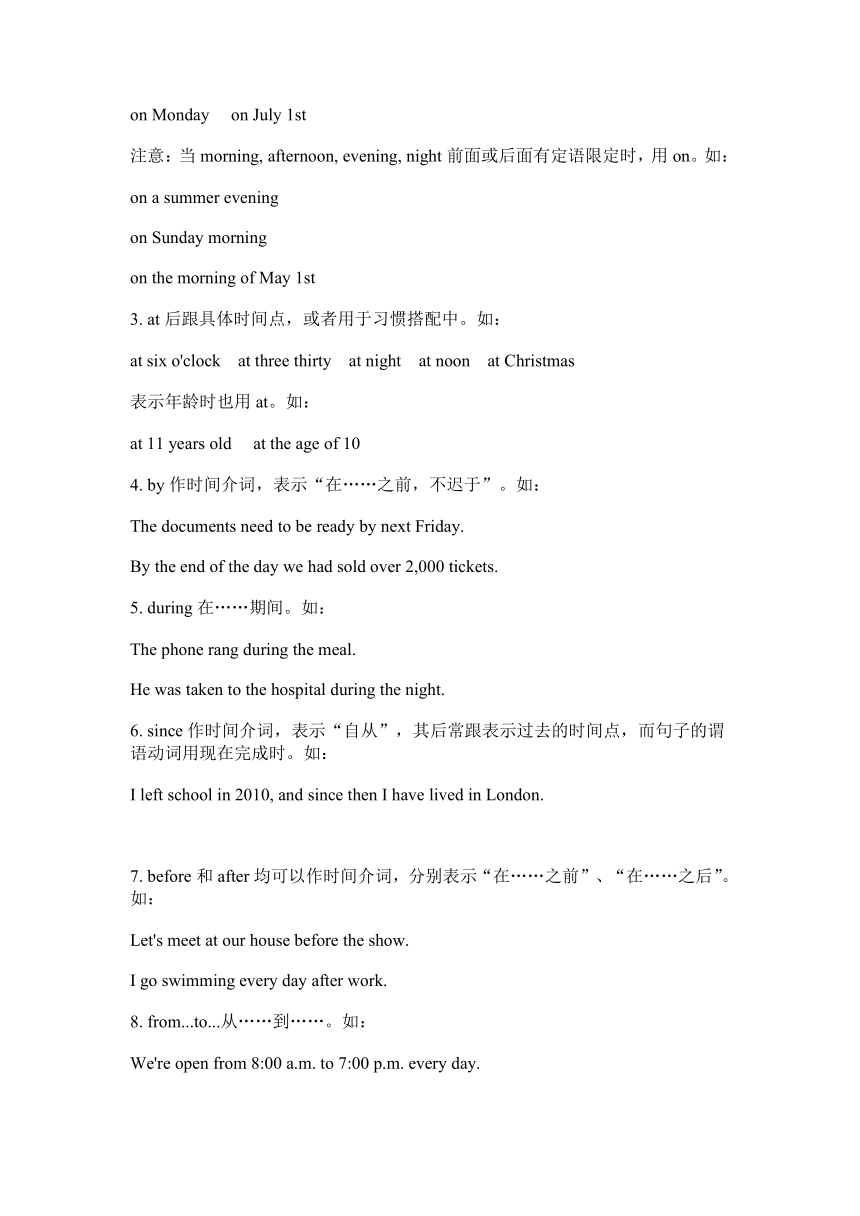2022年中考英语语法复习讲义二数词,介词,连词,形容词,副词
文档属性
| 名称 | 2022年中考英语语法复习讲义二数词,介词,连词,形容词,副词 |  | |
| 格式 | docx | ||
| 文件大小 | 84.2KB | ||
| 资源类型 | 教案 | ||
| 版本资源 | 通用版 | ||
| 科目 | 英语 | ||
| 更新时间 | 2022-01-19 14:22:21 | ||
图片预览





文档简介
语法二
A.复合不定代词的综合运用
B.数词的综合运用考查
C.表示时间的介词(综合)
D.方位介词的常考考点
E.并列连词综合考点
F.形容词原级、比较级和最高级的综合运用
G.形容词的原级、比较级和最高级的转换
H.副词原级、比较级和最高级的综合运用
复合不定代词的综合运用
复合不定代词包括something, somebody, someone, anything, anybody, anyone, nothing, nobody, no one, everything, everybody, everyone 等等,在句中可作主语、宾语或表语等。something, someone 等和anything, anyone等的区别与some 和any 的区别一样,前者一般用于肯定句,后者一般用于否定句、疑问句等。使用复合不定代词时应注意以下几点:
1. 作主语时视为单数,谓语用第三人称单数形式。
例:He found that nobody was in the classroom.
他发现教室里没有人。
2. 有形容词或不定式修饰时,形容词或不定式要后置。
例:There is something interesting in this book.
这本书里有一些有趣的东西。
He has nothing to do all day.
他整天无所事事。
3. some-复合不定代词通常用于肯定句以及带有肯定意向的疑问句,any-复合不定代词则通常用于否定句和疑问句。
例:I wanted to buy something for my mum last week, but I didn't buy anything in the end.
上周我想给妈妈买点东西,但最后什么也没买。
Would you like something to drink (礼貌征询意见,希望得到肯定回答的疑问句)你想喝点什么吗?
Do you have anything to drink (一般情况的疑问句)
你有什么喝的吗?
4. 复合不定代词的否定。
not every-表示的是部分否定,意为“并非都,不都”。
not any-和no-均表示全否定。
例:Not everything will go well.
不是一切都会好的。
No one was at home.
没有人在家。
B.数词的综合运用考查
数词的分类:基数词和序数词
基数词:表示人或者事物数量多少的词。
序数词:表示人或者事物顺序的词。
数词的用法:
表编号 名词(首字母要大写)+基数词=the +序数词+名词
Lesson One=the first lesson
基数词的复数形式表示面带和年龄
表示年代:in the+年份的复数 几世纪几十年代 in the 1930s
表年龄:in one’s+整十的复数 表示在某人几十岁时 in my 20s
hundred/thousand/million/billion
若hundred/thousand/million/billion前有基数词时(表示具体的数目),其后不加s,也不加of; two hundred
若没有时(表示布局图的数目),既要加s也要加of.“hundreds/thousands/millions/billions of +名词
序数词前一般加定冠词the,但序数词前与不定冠词a/an连用时,表示“又一,再一”。
如:You are the second and I am the fourth. 你第二,我第四。(表示顺序)Can you do it a third time 你能再做一次吗?(已经做过两次了)
分数表示法:分数是以基数词代表分子,序数词代表分母,除了分子是“1”的情况外,分母的序数词都要用复数。1/2:a half 1/3:one third 2/3:two thirds 1/4:a (one) quarter 或one fourth。
分数在句子中作主语的时候,谓语动词的单、复数形式由of后面的名词来决定。如果of后面的名词是可数名词的复数形式,谓语动词用复数形式;如果of后面的名词是不可数名词,谓语动词用第三人称单数形式。
如:It is said that two thirds of information on the Internet is not true. 据说互联网上三分之二的信息是不真实的。
Two fifths of the students in my class are from the village. 我们班五分之二的学生来自那个村子。
4.年、月、日、时的表示法
a. 年代890 eight hundred and ninety 1984 nineteen eighty-four 2000 two thousand 2009 two thousand and nine 1
990's (1990s) nineteen nineties 二十世纪九十年代
b. 日期
September 1, 2009, 读作:September the first, two thousand and nine
c. 时刻
C.表示时间的介词(综合)
in大于一天 in Apirl, in spring, in 2018
On 等于一天 on Sunday, on teachers’ Day
at小于一天 at seven/noon/night
1. in可用在月份、年份、季节以及年代、世纪等时间前,或用在一段时间前表示“……之后”,如:
in January in 1999 in winter
in the 2020s in the 21st century in three days
in也可以用于下列短语:
in the morning in the afternoon in the evening
2. on指在具体某一天,如:
on Monday on July 1st
注意:当morning, afternoon, evening, night前面或后面有定语限定时,用on。如:
on a summer evening
on Sunday morning
on the morning of May 1st
3. at后跟具体时间点,或者用于习惯搭配中。如:
at six o'clock at three thirty at night at noon at Christmas
表示年龄时也用at。如:
at 11 years old at the age of 10
4. by作时间介词,表示“在……之前,不迟于”。如:
The documents need to be ready by next Friday.
By the end of the day we had sold over 2,000 tickets.
5. during 在……期间。如:
The phone rang during the meal.
He was taken to the hospital during the night.
6. since作时间介词,表示“自从”,其后常跟表示过去的时间点,而句子的谓语动词用现在完成时。如:
I left school in 2010, and since then I have lived in London.
7. before和after均可以作时间介词,分别表示“在……之前”、“在……之后”。如:
Let's meet at our house before the show.
I go swimming every day after work.
8. from...to...从……到……。如:
We're open from 8:00 a.m. to 7:00 p.m. every day.
9. through自始至终,贯穿。如:
The cold weather continued through the spring.
10. until/till作时间介词表示“直到”,常和延续性动词连用,注意till不可位于句首。当句子动词为短暂性动词时,要用not...until/till结构,表示“直到……才”。如:
I waited until 3 o'clock in the morning, but he didn't come back.
The noise of the streets didn't stop until midnight.
D.方位介词的常考考点
1. above/over
over指在物体的正上方;above则指在高于某物的地方。
We are flying above the clouds. 我们在云层上面飞行。
There is a lamp hanging over the table. 桌子上方吊着一盏灯。
2. next to/near
next to意为“在……旁边,紧挨着……”;near 意为“在……附近”。
My book is next to your book. 我的书在你的书旁边。
There is a tree near our school. 我们学校附近有一棵树。
3. behind/in front of/in the front of
behind表示“在……后面”;in front of表示“在某物外部的前面”;in the front of表示“在某物内部的前面”。
Winnie hides herself behind the curtain. Winnie躲在了窗帘的后面。
They are singing in front of the audience. 他们正在听众面前唱歌。
I'd like a seat in the front of the plane. 我想要靠飞机前段的的座位。
4. in/on/at
in表示在某区域内、在一个空间的内部;on表示“在……上”,并与之相接触;at表示“在某地点”,强调在某个位置点。
The cat is in the box. 这只猫在箱子里。
These cats are lying on the sofa. 这些猫正躺在沙发上。
Jack is at home. Jack在家。
5. across/through
across表示“从物体表面横跨,穿越”;through表示“从……里面穿过”。
They are walking across the street. 他们正在过马路。
The train is passing through the tunnel. 火车正在穿越隧道。
6. between/among
between...and...意为“在……和……之间”,一般用于两者之间。among意为“在……之间,被……环绕”,用于表示三者或三者以上的事物。
如:He sits between Tom and Danny. 他坐在Tom和Danny之间。
The old man is working among the flowers. 那位老人正在花丛中工作。
7. opposite
opposite作为介词,意为“与……相对;在……对面”。
如:There is a bank opposite the supermarket. 超市对面有一家银行。
E.并列连词综合考点
并列连词and, but, or, so, both… and…, not only… but (also)…, either… or…, neither… nor…
1. and的用法
并列连词and意为“和,又”,表示并列关系,常用来连接表示对等成分的单词、短语或者句子,表示意思的顺延或增补。例如:
(1) Our math teacher is kind and helpful. 我们的数学老师既善良又乐于助人。
(2) I went to the supermarket and bought some vegetables this morning. 我今天早上去超市买了一些蔬菜。
(3) Her uncle gave her a new bike as her birthday present and she liked it very much. 她叔叔给她买了一辆新自行车作为生日礼物,她很喜欢。(连接两个简单句,表示意思的顺延)
and用作并列连词有多重含义,除了表示并列关系外,还可以表示目的(and之后)、条件(and之前)等关系。例如:
(4) Come and see my grandfather. 来看望我的爷爷。(see my grandfather是come的目的)
(5) Be careful, and you will make fewer mistakes. 仔细一点,这样你犯的错误就更少了。(Be careful表示条件,you will make fewer mistakes. 表示结果)
2.but的用法
并列连词but意为“但是”,表示转折关系,所连接的成分意思相反或相对。例如:
(1) Our school is small but beautiful. 我们的学校很小,但很美。
(2) The car is very old but it runs very fast. 这辆车很旧,但跑得很快。
3.or的用法
并列连词or意为“或者”,表示选择关系。例如:
(1) Do you often go to school on foot or by bike 你通常步行去学校还是骑自行车去学校?
(2) You can stay here, or you can leave. 你要么留在这里,要么离开。
另外,在否定句中连接并列成分时,用or,而不用and,例如:
(3) I can't speak English or French. 我不会讲英语和法语。(不能使用and)
英语中,“祈使句+or+简单句”结构,也是一种常用句型。句型中,or意为“否则”,祈使句相当于一个条件,可以和以“if”引导的条件状语从句进行转换。例如:
(4) Put on your coat, or you will catch a cold. = If you don't put on your coat, you will catch a cold.穿上外套,否则你会感冒。(转换成以“if”引导的条件状语从句时,要去掉并列连词or)
4.so的用法
并列连词so表示“因此、所以”之意,常用来连接两个简单句,这两个简单句有意思上的因果关系。例如:
(1) The rain began to fall, so we went home. 雨开始下了,所以我们回家了。
(2) Everyone in the town knew him, so we had no trouble finding his house.
小镇里的每个人都知道他,所以我们毫不费力地找到了他的房子。
so和从属连词because(因为)不能一起连用。也就是说,使用了并列连词,就不用because(从属连词);使用了because,就不能用so。例如:
(3) He was ill, so he didn't go to school. 他生病了,所以他没有去上学。(本句是一个由并列连词so连接的并列句)
5. both… and…意为“既……又……,……和……都”。例如:
(1) Both New York and London have traffic problems. 纽约和伦敦都存在交通问题。
(2) He both speaks and writes Spanish. 他既会说也会写西班牙语。
注意:当both… and…连接两个成分在句中作主语时,谓语动词总是用复数形式。例如:
Both she and I are good at English. 她和我都擅长英语。
6. not only… but (also)… 意为“不仅……而且……;不但……而且……”,其中also也可以省略。通常用于连接两个相同的句子成分,即所谓的“对称结构”。例如:
(1) Not only I but also Tom and Mary are fond of watching television.不仅我,而且Tom和Mary都喜欢看电视。
(2) He not only goes to work on weekdays, but also on weekends. 他不仅工作日去上班,周末也去上班。
注意:当not only… but (also)… 连接两个名词作主语时,其谓语动词应与就近的一个主语在人称上保持一致,这就是我们通常说的“就近原则”。例如:
Not only the students but also their teacher is watching the film. 不仅学生们在观赏这部影片,他们的老师也在观赏这部影片。
7. either… or…意为“要么……要么……;或者……或者……;不是……就是……”之意。表示两者之一,用于连接表示选择关系的成分。例如:
(1) When the girl is happy, she either sings or dances. 那个女孩高兴时,不是唱就是跳。
(2) Either you or she is good at drawing. 要么你,要么她擅长绘画。
注意:either...or... 连接两个主语时,应遵循“就近原则”。例如:
Either you or I am going there tomorrow. 明天要么你去那里,要么我去那里。
8. neither… nor…表示“既不……也不……”。其含义是否定的,可连接两个并列的成分。例如:
(1) She likes neither butter nor cheese. 她既不喜欢黄油也不喜欢乳酪。
(2) Neither you nor she is good at drawing. 你和她都不擅长绘画。
注意:当neither...nor...连接两个主语时,也应遵循“就近原则”。例如:
Neither my parents nor I am at home today. 今天我父母和我都不在家。
F.形容词原级、比较级和最高级的综合运用
范围=1 形单影只:形容词原级
比较范围=2 不相上下:形容词的同级比较肯定结构 胜负已分:形容词的同级比较否定结构 形容词的比较级
比较范围≥3 独孤称霸:形容词的最高级
一、形容词的同级比较
1)“as + 形容词原级 + as …”意为“……和……一样”,为形容词的同级比较结构。第一个as为副词,第二个as为连词。
You look as young as he (looks). 你看起来和他一样年轻。
Lucy is as tall as Lily. Lucy和Lily一样高。
2) 否定式:not as/so +形容词原级 +as 意为“不如……”,常可与less+形容词原级+than互换。
This book is not as/so interesting as that one. 这本书没有那本有趣。
Lucy isn't as/so tall as Lily.
=Lucy is less tall than Lily.
Lucy不如Lily高。
形容词比较级
1. 表示两者进行比较时用形容词比较级,其结构为“A+be+形容词比较级+than+B”。如:
Lily's room is bigger than mine. Lily的房间比我的大。
2. 形容词比较级前面可加a lot/much/far/a bit/a little等修饰词,表示程度。如:
It is much colder today than yesterday. 今天比昨天冷得多。
3. 表示两者之间进行选择“哪一个更……”时,用句型“Which/Who+be+形容词比较级,A or B ”表示。如:
Who is taller, Li Ming or Wang Tao 谁比较高,李明还是王涛?
4. 表示“两者中比较……的一个(of the two)”时,常用“the+比较级”结构。
如:
Mary is the taller of the twins. Mary是双胞胎中比较高的那个。
5. 表示“越来越……”,用比较级重叠结构,即“比较级+and+比较级”,当形容词为多音节或部分双音节时,用“more and more+形容词原级”。如:
It's getting warmer and warmer in spring. 春天天气变得越来越暖和。
6. 表示“越……越……”时,用“the+比较级,the+比较级”结构,如:
The more, the better. 越多越好。
三、形容词最高级
1. 表示三者或三者以上的人或物进行比较时,用最高级形式。形容词最高级前要加定冠词the,句末通常跟一个in/of短语来表示范围。如:
Beijing is one of the biggest cities in China.
北京是中国最大的城市之一。
2. 表示在三者或三者以上的人或物进行选择时,用“Which/Who+be+the+形容词最高级, A, B or C ”结构,如:
Which city is the most beautiful, Beijing, Shanghai or Fuzhou
哪座城市最漂亮,北京,上海还是福州?
3. 表示“最……的……之一”时,用“one of the+形容词最高级”结构,该形容词后面的名词要用复数形式。如:
Jay Chou is one of the most popular singers. 周杰伦是最受欢迎的歌手之一。
4. 形容词最高级前面可以加序数词,表示“第几最……”。如:
The Yellow River is the second longest river in China. 黄河是中国第二长河。
5. 形容词最高级前面可以用物主代词、指示代词、名词所有格修饰,此时不能再用定冠词。如:
This is our best lesson today. 这是我们今天最好的一节课。
6. 形容词比较级结构可以表示最高级含义。如:
Li Lei is taller than any other student in his class.
李雷比班上其他任何一个学生都高。
= Li Lei is the tallest student in his class.
李雷是他班上最高的学生。
G.形容词的原级、比较级和最高级的转换
1.形容词原级比较as…as…
as...as…意为“和……一样”,表示同级的比较。第一个as为副词,第二个as为连词。其基本结构为:as+ adj./ adv. +as,其否定式为not as/so +adj./ adv. +as。例:
This dictionary is not as/so useful as you think.这本字典不如你认为的那样有用。
2.形容词比较级和最高级的用法
1)表示两者的比较时用比较级,通常用“形容词比较级+than”的结构。例:
I am much better than I was yesterday.我比昨天好多了。
Maths is less interesting than English.数学不如英语有趣。
2)表示一定范围内两者以上的比较时,用最高级,通常用“the+形容词最高级(+名词)+of (in)...”的结构。例:
This is the busiest day of the week.这是本周最繁忙的一天。
3)形容词比较级的其他用法:
(1)比较级前面可以用much、far、a little、a bit、a lot等词修饰表示程度。例:
The sun is much bigger than the earth.太阳比地球大多了。
(2)两个形容词和副词的比较级可以叠加表示“越来越……”的意思。
其结构可以是:比较级+and+比较级,而部分双音节词及多音节词可以用more and more+原级。例:
The days are getting longer and longer.天正变得越来越长了。
(3) 如果表示“越……,就越……”可以用“the+比较级……,the+比较级……”的结构。例:
The more, the better.越多越好。
3.形容词原级、比较级和最高级可转换:示例如下:
她是她们班最好的学生。
l最高级:She is the best in her class.
l比较级:She is better than any other student in her class./No other student in her class is better than her.
l原级:No other student in her class is as good as her.
H.副词原级、比较级和最高级的综合运用
一、副词同级比较的用法
(1)“as + 副词原级 + as …”意为“……和……一样”,为副词的同级比较结构。第一个as为副词,第二个as为连词。
He worked just as hard as anyone. 他和所有人一样非常努力。
(2) 否定式:not as/so +副词原级+as 意为“不如……”。常可与less+副词原级+than互换。
Mary does not work as/so carefully as John does. Mary工作不如John细心。
Tom doesn't run as/so quickly as Jim.
=Tom runs less quickly than Jim.
Tom跑得不如Jim快。
二、副词比较级和最高级
1. 副词比较级的用法
(1) 用“比较级+than”结构可以表达一方超过另一方的情况,也可以表达一方不如一方的情况。
Tom is hard-working. I work harder than him.
Tom工作很努力,我比他更努力。
John walked more slowly than other boys did.
John比其他的男孩走得慢。
(2)“比较级+and+比较级”或“more and more+原级”表示某种情况变得“越来越……”。
With time going on, we are getting on better and better with one another.
随着时间的流逝,我们彼此之间相处得越来越好。
It rained more and more heavily. 雨下得越来越大了。
(3)“the +比较级,the +比较级”表示一方的程度随着另一方的程度平行变化,意为“越……,(就)越……”。
The more we know each other, the better we understand each other.
我们彼此了解越多,就越能互相理解。
2. 副词最高级的用法
与形容词最高级用法基本相同。主要运用“the+副词最高级+表示范围的短语”结构。最高级前的定冠词the可省略。
He runs (the) fastest in our class. 他在我们班跑得最快。
Who sings (the) most beautifully of the three 他们三个人中谁唱得最动听?
A.复合不定代词的综合运用
B.数词的综合运用考查
C.表示时间的介词(综合)
D.方位介词的常考考点
E.并列连词综合考点
F.形容词原级、比较级和最高级的综合运用
G.形容词的原级、比较级和最高级的转换
H.副词原级、比较级和最高级的综合运用
复合不定代词的综合运用
复合不定代词包括something, somebody, someone, anything, anybody, anyone, nothing, nobody, no one, everything, everybody, everyone 等等,在句中可作主语、宾语或表语等。something, someone 等和anything, anyone等的区别与some 和any 的区别一样,前者一般用于肯定句,后者一般用于否定句、疑问句等。使用复合不定代词时应注意以下几点:
1. 作主语时视为单数,谓语用第三人称单数形式。
例:He found that nobody was in the classroom.
他发现教室里没有人。
2. 有形容词或不定式修饰时,形容词或不定式要后置。
例:There is something interesting in this book.
这本书里有一些有趣的东西。
He has nothing to do all day.
他整天无所事事。
3. some-复合不定代词通常用于肯定句以及带有肯定意向的疑问句,any-复合不定代词则通常用于否定句和疑问句。
例:I wanted to buy something for my mum last week, but I didn't buy anything in the end.
上周我想给妈妈买点东西,但最后什么也没买。
Would you like something to drink (礼貌征询意见,希望得到肯定回答的疑问句)你想喝点什么吗?
Do you have anything to drink (一般情况的疑问句)
你有什么喝的吗?
4. 复合不定代词的否定。
not every-表示的是部分否定,意为“并非都,不都”。
not any-和no-均表示全否定。
例:Not everything will go well.
不是一切都会好的。
No one was at home.
没有人在家。
B.数词的综合运用考查
数词的分类:基数词和序数词
基数词:表示人或者事物数量多少的词。
序数词:表示人或者事物顺序的词。
数词的用法:
表编号 名词(首字母要大写)+基数词=the +序数词+名词
Lesson One=the first lesson
基数词的复数形式表示面带和年龄
表示年代:in the+年份的复数 几世纪几十年代 in the 1930s
表年龄:in one’s+整十的复数 表示在某人几十岁时 in my 20s
hundred/thousand/million/billion
若hundred/thousand/million/billion前有基数词时(表示具体的数目),其后不加s,也不加of; two hundred
若没有时(表示布局图的数目),既要加s也要加of.“hundreds/thousands/millions/billions of +名词
序数词前一般加定冠词the,但序数词前与不定冠词a/an连用时,表示“又一,再一”。
如:You are the second and I am the fourth. 你第二,我第四。(表示顺序)Can you do it a third time 你能再做一次吗?(已经做过两次了)
分数表示法:分数是以基数词代表分子,序数词代表分母,除了分子是“1”的情况外,分母的序数词都要用复数。1/2:a half 1/3:one third 2/3:two thirds 1/4:a (one) quarter 或one fourth。
分数在句子中作主语的时候,谓语动词的单、复数形式由of后面的名词来决定。如果of后面的名词是可数名词的复数形式,谓语动词用复数形式;如果of后面的名词是不可数名词,谓语动词用第三人称单数形式。
如:It is said that two thirds of information on the Internet is not true. 据说互联网上三分之二的信息是不真实的。
Two fifths of the students in my class are from the village. 我们班五分之二的学生来自那个村子。
4.年、月、日、时的表示法
a. 年代890 eight hundred and ninety 1984 nineteen eighty-four 2000 two thousand 2009 two thousand and nine 1
990's (1990s) nineteen nineties 二十世纪九十年代
b. 日期
September 1, 2009, 读作:September the first, two thousand and nine
c. 时刻
C.表示时间的介词(综合)
in大于一天 in Apirl, in spring, in 2018
On 等于一天 on Sunday, on teachers’ Day
at小于一天 at seven/noon/night
1. in可用在月份、年份、季节以及年代、世纪等时间前,或用在一段时间前表示“……之后”,如:
in January in 1999 in winter
in the 2020s in the 21st century in three days
in也可以用于下列短语:
in the morning in the afternoon in the evening
2. on指在具体某一天,如:
on Monday on July 1st
注意:当morning, afternoon, evening, night前面或后面有定语限定时,用on。如:
on a summer evening
on Sunday morning
on the morning of May 1st
3. at后跟具体时间点,或者用于习惯搭配中。如:
at six o'clock at three thirty at night at noon at Christmas
表示年龄时也用at。如:
at 11 years old at the age of 10
4. by作时间介词,表示“在……之前,不迟于”。如:
The documents need to be ready by next Friday.
By the end of the day we had sold over 2,000 tickets.
5. during 在……期间。如:
The phone rang during the meal.
He was taken to the hospital during the night.
6. since作时间介词,表示“自从”,其后常跟表示过去的时间点,而句子的谓语动词用现在完成时。如:
I left school in 2010, and since then I have lived in London.
7. before和after均可以作时间介词,分别表示“在……之前”、“在……之后”。如:
Let's meet at our house before the show.
I go swimming every day after work.
8. from...to...从……到……。如:
We're open from 8:00 a.m. to 7:00 p.m. every day.
9. through自始至终,贯穿。如:
The cold weather continued through the spring.
10. until/till作时间介词表示“直到”,常和延续性动词连用,注意till不可位于句首。当句子动词为短暂性动词时,要用not...until/till结构,表示“直到……才”。如:
I waited until 3 o'clock in the morning, but he didn't come back.
The noise of the streets didn't stop until midnight.
D.方位介词的常考考点
1. above/over
over指在物体的正上方;above则指在高于某物的地方。
We are flying above the clouds. 我们在云层上面飞行。
There is a lamp hanging over the table. 桌子上方吊着一盏灯。
2. next to/near
next to意为“在……旁边,紧挨着……”;near 意为“在……附近”。
My book is next to your book. 我的书在你的书旁边。
There is a tree near our school. 我们学校附近有一棵树。
3. behind/in front of/in the front of
behind表示“在……后面”;in front of表示“在某物外部的前面”;in the front of表示“在某物内部的前面”。
Winnie hides herself behind the curtain. Winnie躲在了窗帘的后面。
They are singing in front of the audience. 他们正在听众面前唱歌。
I'd like a seat in the front of the plane. 我想要靠飞机前段的的座位。
4. in/on/at
in表示在某区域内、在一个空间的内部;on表示“在……上”,并与之相接触;at表示“在某地点”,强调在某个位置点。
The cat is in the box. 这只猫在箱子里。
These cats are lying on the sofa. 这些猫正躺在沙发上。
Jack is at home. Jack在家。
5. across/through
across表示“从物体表面横跨,穿越”;through表示“从……里面穿过”。
They are walking across the street. 他们正在过马路。
The train is passing through the tunnel. 火车正在穿越隧道。
6. between/among
between...and...意为“在……和……之间”,一般用于两者之间。among意为“在……之间,被……环绕”,用于表示三者或三者以上的事物。
如:He sits between Tom and Danny. 他坐在Tom和Danny之间。
The old man is working among the flowers. 那位老人正在花丛中工作。
7. opposite
opposite作为介词,意为“与……相对;在……对面”。
如:There is a bank opposite the supermarket. 超市对面有一家银行。
E.并列连词综合考点
并列连词and, but, or, so, both… and…, not only… but (also)…, either… or…, neither… nor…
1. and的用法
并列连词and意为“和,又”,表示并列关系,常用来连接表示对等成分的单词、短语或者句子,表示意思的顺延或增补。例如:
(1) Our math teacher is kind and helpful. 我们的数学老师既善良又乐于助人。
(2) I went to the supermarket and bought some vegetables this morning. 我今天早上去超市买了一些蔬菜。
(3) Her uncle gave her a new bike as her birthday present and she liked it very much. 她叔叔给她买了一辆新自行车作为生日礼物,她很喜欢。(连接两个简单句,表示意思的顺延)
and用作并列连词有多重含义,除了表示并列关系外,还可以表示目的(and之后)、条件(and之前)等关系。例如:
(4) Come and see my grandfather. 来看望我的爷爷。(see my grandfather是come的目的)
(5) Be careful, and you will make fewer mistakes. 仔细一点,这样你犯的错误就更少了。(Be careful表示条件,you will make fewer mistakes. 表示结果)
2.but的用法
并列连词but意为“但是”,表示转折关系,所连接的成分意思相反或相对。例如:
(1) Our school is small but beautiful. 我们的学校很小,但很美。
(2) The car is very old but it runs very fast. 这辆车很旧,但跑得很快。
3.or的用法
并列连词or意为“或者”,表示选择关系。例如:
(1) Do you often go to school on foot or by bike 你通常步行去学校还是骑自行车去学校?
(2) You can stay here, or you can leave. 你要么留在这里,要么离开。
另外,在否定句中连接并列成分时,用or,而不用and,例如:
(3) I can't speak English or French. 我不会讲英语和法语。(不能使用and)
英语中,“祈使句+or+简单句”结构,也是一种常用句型。句型中,or意为“否则”,祈使句相当于一个条件,可以和以“if”引导的条件状语从句进行转换。例如:
(4) Put on your coat, or you will catch a cold. = If you don't put on your coat, you will catch a cold.穿上外套,否则你会感冒。(转换成以“if”引导的条件状语从句时,要去掉并列连词or)
4.so的用法
并列连词so表示“因此、所以”之意,常用来连接两个简单句,这两个简单句有意思上的因果关系。例如:
(1) The rain began to fall, so we went home. 雨开始下了,所以我们回家了。
(2) Everyone in the town knew him, so we had no trouble finding his house.
小镇里的每个人都知道他,所以我们毫不费力地找到了他的房子。
so和从属连词because(因为)不能一起连用。也就是说,使用了并列连词,就不用because(从属连词);使用了because,就不能用so。例如:
(3) He was ill, so he didn't go to school. 他生病了,所以他没有去上学。(本句是一个由并列连词so连接的并列句)
5. both… and…意为“既……又……,……和……都”。例如:
(1) Both New York and London have traffic problems. 纽约和伦敦都存在交通问题。
(2) He both speaks and writes Spanish. 他既会说也会写西班牙语。
注意:当both… and…连接两个成分在句中作主语时,谓语动词总是用复数形式。例如:
Both she and I are good at English. 她和我都擅长英语。
6. not only… but (also)… 意为“不仅……而且……;不但……而且……”,其中also也可以省略。通常用于连接两个相同的句子成分,即所谓的“对称结构”。例如:
(1) Not only I but also Tom and Mary are fond of watching television.不仅我,而且Tom和Mary都喜欢看电视。
(2) He not only goes to work on weekdays, but also on weekends. 他不仅工作日去上班,周末也去上班。
注意:当not only… but (also)… 连接两个名词作主语时,其谓语动词应与就近的一个主语在人称上保持一致,这就是我们通常说的“就近原则”。例如:
Not only the students but also their teacher is watching the film. 不仅学生们在观赏这部影片,他们的老师也在观赏这部影片。
7. either… or…意为“要么……要么……;或者……或者……;不是……就是……”之意。表示两者之一,用于连接表示选择关系的成分。例如:
(1) When the girl is happy, she either sings or dances. 那个女孩高兴时,不是唱就是跳。
(2) Either you or she is good at drawing. 要么你,要么她擅长绘画。
注意:either...or... 连接两个主语时,应遵循“就近原则”。例如:
Either you or I am going there tomorrow. 明天要么你去那里,要么我去那里。
8. neither… nor…表示“既不……也不……”。其含义是否定的,可连接两个并列的成分。例如:
(1) She likes neither butter nor cheese. 她既不喜欢黄油也不喜欢乳酪。
(2) Neither you nor she is good at drawing. 你和她都不擅长绘画。
注意:当neither...nor...连接两个主语时,也应遵循“就近原则”。例如:
Neither my parents nor I am at home today. 今天我父母和我都不在家。
F.形容词原级、比较级和最高级的综合运用
范围=1 形单影只:形容词原级
比较范围=2 不相上下:形容词的同级比较肯定结构 胜负已分:形容词的同级比较否定结构 形容词的比较级
比较范围≥3 独孤称霸:形容词的最高级
一、形容词的同级比较
1)“as + 形容词原级 + as …”意为“……和……一样”,为形容词的同级比较结构。第一个as为副词,第二个as为连词。
You look as young as he (looks). 你看起来和他一样年轻。
Lucy is as tall as Lily. Lucy和Lily一样高。
2) 否定式:not as/so +形容词原级 +as 意为“不如……”,常可与less+形容词原级+than互换。
This book is not as/so interesting as that one. 这本书没有那本有趣。
Lucy isn't as/so tall as Lily.
=Lucy is less tall than Lily.
Lucy不如Lily高。
形容词比较级
1. 表示两者进行比较时用形容词比较级,其结构为“A+be+形容词比较级+than+B”。如:
Lily's room is bigger than mine. Lily的房间比我的大。
2. 形容词比较级前面可加a lot/much/far/a bit/a little等修饰词,表示程度。如:
It is much colder today than yesterday. 今天比昨天冷得多。
3. 表示两者之间进行选择“哪一个更……”时,用句型“Which/Who+be+形容词比较级,A or B ”表示。如:
Who is taller, Li Ming or Wang Tao 谁比较高,李明还是王涛?
4. 表示“两者中比较……的一个(of the two)”时,常用“the+比较级”结构。
如:
Mary is the taller of the twins. Mary是双胞胎中比较高的那个。
5. 表示“越来越……”,用比较级重叠结构,即“比较级+and+比较级”,当形容词为多音节或部分双音节时,用“more and more+形容词原级”。如:
It's getting warmer and warmer in spring. 春天天气变得越来越暖和。
6. 表示“越……越……”时,用“the+比较级,the+比较级”结构,如:
The more, the better. 越多越好。
三、形容词最高级
1. 表示三者或三者以上的人或物进行比较时,用最高级形式。形容词最高级前要加定冠词the,句末通常跟一个in/of短语来表示范围。如:
Beijing is one of the biggest cities in China.
北京是中国最大的城市之一。
2. 表示在三者或三者以上的人或物进行选择时,用“Which/Who+be+the+形容词最高级, A, B or C ”结构,如:
Which city is the most beautiful, Beijing, Shanghai or Fuzhou
哪座城市最漂亮,北京,上海还是福州?
3. 表示“最……的……之一”时,用“one of the+形容词最高级”结构,该形容词后面的名词要用复数形式。如:
Jay Chou is one of the most popular singers. 周杰伦是最受欢迎的歌手之一。
4. 形容词最高级前面可以加序数词,表示“第几最……”。如:
The Yellow River is the second longest river in China. 黄河是中国第二长河。
5. 形容词最高级前面可以用物主代词、指示代词、名词所有格修饰,此时不能再用定冠词。如:
This is our best lesson today. 这是我们今天最好的一节课。
6. 形容词比较级结构可以表示最高级含义。如:
Li Lei is taller than any other student in his class.
李雷比班上其他任何一个学生都高。
= Li Lei is the tallest student in his class.
李雷是他班上最高的学生。
G.形容词的原级、比较级和最高级的转换
1.形容词原级比较as…as…
as...as…意为“和……一样”,表示同级的比较。第一个as为副词,第二个as为连词。其基本结构为:as+ adj./ adv. +as,其否定式为not as/so +adj./ adv. +as。例:
This dictionary is not as/so useful as you think.这本字典不如你认为的那样有用。
2.形容词比较级和最高级的用法
1)表示两者的比较时用比较级,通常用“形容词比较级+than”的结构。例:
I am much better than I was yesterday.我比昨天好多了。
Maths is less interesting than English.数学不如英语有趣。
2)表示一定范围内两者以上的比较时,用最高级,通常用“the+形容词最高级(+名词)+of (in)...”的结构。例:
This is the busiest day of the week.这是本周最繁忙的一天。
3)形容词比较级的其他用法:
(1)比较级前面可以用much、far、a little、a bit、a lot等词修饰表示程度。例:
The sun is much bigger than the earth.太阳比地球大多了。
(2)两个形容词和副词的比较级可以叠加表示“越来越……”的意思。
其结构可以是:比较级+and+比较级,而部分双音节词及多音节词可以用more and more+原级。例:
The days are getting longer and longer.天正变得越来越长了。
(3) 如果表示“越……,就越……”可以用“the+比较级……,the+比较级……”的结构。例:
The more, the better.越多越好。
3.形容词原级、比较级和最高级可转换:示例如下:
她是她们班最好的学生。
l最高级:She is the best in her class.
l比较级:She is better than any other student in her class./No other student in her class is better than her.
l原级:No other student in her class is as good as her.
H.副词原级、比较级和最高级的综合运用
一、副词同级比较的用法
(1)“as + 副词原级 + as …”意为“……和……一样”,为副词的同级比较结构。第一个as为副词,第二个as为连词。
He worked just as hard as anyone. 他和所有人一样非常努力。
(2) 否定式:not as/so +副词原级+as 意为“不如……”。常可与less+副词原级+than互换。
Mary does not work as/so carefully as John does. Mary工作不如John细心。
Tom doesn't run as/so quickly as Jim.
=Tom runs less quickly than Jim.
Tom跑得不如Jim快。
二、副词比较级和最高级
1. 副词比较级的用法
(1) 用“比较级+than”结构可以表达一方超过另一方的情况,也可以表达一方不如一方的情况。
Tom is hard-working. I work harder than him.
Tom工作很努力,我比他更努力。
John walked more slowly than other boys did.
John比其他的男孩走得慢。
(2)“比较级+and+比较级”或“more and more+原级”表示某种情况变得“越来越……”。
With time going on, we are getting on better and better with one another.
随着时间的流逝,我们彼此之间相处得越来越好。
It rained more and more heavily. 雨下得越来越大了。
(3)“the +比较级,the +比较级”表示一方的程度随着另一方的程度平行变化,意为“越……,(就)越……”。
The more we know each other, the better we understand each other.
我们彼此了解越多,就越能互相理解。
2. 副词最高级的用法
与形容词最高级用法基本相同。主要运用“the+副词最高级+表示范围的短语”结构。最高级前的定冠词the可省略。
He runs (the) fastest in our class. 他在我们班跑得最快。
Who sings (the) most beautifully of the three 他们三个人中谁唱得最动听?
同课章节目录
- 词法
- 名词
- 动词和动词短语
- 动词语态
- 动词时态
- 助动词和情态动词
- 非谓语动词
- 冠词
- 代词
- 数词和量词
- 形容词副词及其比较等级
- 介词和介词短语
- 连词和感叹词
- 构词法
- 相似、相近词比较
- 句法
- 陈述句
- 一般疑问句和否定疑问句
- 特殊疑问句及选择疑问句
- 反意疑问句
- 存在句(There be句型)
- 宾语从句
- 定语从句
- 状语从句
- 主谓一致问题
- 简单句
- 并列句
- 复合句
- 主谓一致
- 主、表语从句
- 名词性从句
- 直接引语和间接引语
- 虚拟语气
- 感叹句
- 强调句
- 倒装句
- 祈使句
- 句子的成分
- 句子的分类
- 题型专区
- 单项选择部分
- 易错题
- 完形填空
- 阅读理解
- 词汇练习
- 听说训练
- 句型转换
- 补全对话
- 短文改错
- 翻译
- 书面表达
- 任务型阅读
- 语法填空
- 其他资料
